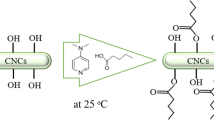Abstract
Amine functionalised nanoclay that can be easily exfoliated in water was used in the preparation of eco-friendly polymer nanocomposite films based on hydroxypropyl methylcellulose (HPMC). These nanocomposite films were characterised using fourier transform infrared spectroscopy (FTIR), X-ray diffraction analysis (XRD) and field emission scanning electron microscopy (FESEM) analysis. Incorporation of this nanoclay helped to improve the mechanical and barrier properties of nanocomposite films. Differential scanning calorimetry (DSC) studies proved that this nanoclay has also affected the thermal properties of HPMC. These nanocomposite films proved to have better properties than conventional montmorillonite containing HPMC nanocomposites.






Similar content being viewed by others
References
Siracusaa V, Rocculib P, Romanib S, Rosa MD (2008) Biodegradable polymers for food packaging: a review. Trends Food Sci Technol 19(12):634–643
Krochta JM, Mulder-Johnston C (1997) Edible and biodegradable polymer films: challenges and opportunities. Food Technol 51(2):61–75
Brindle LP, Krochta JM (2008) Physical properties of whey protein hydroxypropyl methylcellulose blend edible films. J Food Sci 73(9):446–454
Bertuzzi MA, Armada M, Gottifredi JC (2007) Physicochemical characterization of starch based films. J Food Eng 82(1):17–25
Lagaron JM, Lòpez-Rubio A (2011) Nanotechnology for bioplastics: opportunities, challenges and strategies. Trends Food Sci Technol 22(11):611–617
Bharadwaj RK (2001) Modelling the barrier properties of polymer-layered silicate nanocomposites. Macromol 34(26):9789–9792
Lu CY, Mai W (2005) Influence of aspect ratio on barrier properties of polymer-clay nanocomposites. Phys Rev Lett 95(8):088303
Alix S, Follain N, Tenn N, Alexandre B, Bourbigot S, Soulestin J, Marais S (2012) Effect of highly exfoliated and oriented organoclays on the barrier properties of polyamide 6 based nanocomposites. J Phys Chem C 116(8):4937–4947
Chivrac F, Pollet E, Avérous L (2009) Progress in nano-biocomposites based on polysaccharides and nanoclays. Mater Sci Eng R 67(1):1–17
Leroux F, Pagano MA, Intissar M, Chauviere S, Forano C, Besse JP (2001) Delamination and restacking of layered double hydroxides. J Mater Chem 11:105–112
Mondal D, Bhowmick B, Mollick MMR, Maity D, Mukhopadhyay A, Rana D, Chattopadhyay D (2013) Effect of clay concentration on morphology and properties of hydroxypropyl methylcellulose films. Carbohydr Polym 96(1):57–63
Muthuswamy E, Walsh D, Mann S (2002) Morphosynthesis of organoclay microspheres with sponge-like or hollow interiors. Adv Mater 14(13–14):969–972
Burkett SL, Press A, Mann S (1997) Synthesis, characterization and reactivity of layered inorganic–organic nanocomposites based on 2:1 trioctahedral phyllosilicates. Chem Mater 9(5):1071–1073
Datta KKR, Achari A, Eswaramoorthy M (2013) Aminoclay: a functional layered material with multifaceted applications. J Mater Chem A 1:6707–6718
Johnsy G, Datta KKR, Sajeevkumar VA, Sabapathy SN, Bawa AS, Eswaramoorthy M (2009) Aminoclay: a designer filler for the synthesis of highly ductile polymer-nanocomposite film. ACS Appl Mater Interface 1(12):2796–2803
Patil AJ, Muthusamy E, Mann S (2004) Synthesis and self‐assembly of organoclay‐wrapped biomolecules. Angew Chem 116(37):5036–5041
Lerot L, Low PF (1976) Effect of swelling on the infrared absorption spectrum of montmorillonite. Clay Mineral 24:191–199
Wang L, Xu Y (2006) γ‐radiation‐induced graft copolymerization of ethyl acrylate onto hydroxypropyl methylcellulose. Macromol Mater Eng 291(8):950–961
Ray SS, Yamada K, Okamoto M, Fujimoto Y, Ogami A, Ueda K (2003) New polylactide / layered silicate nanocomposites. 5. Designing of materials with desired properties. Polym 44(21):6633–6646
Maiti P, Okamoto M (2003) Crystallization controlled by silicate surfaces in Nylon 6-clay nanocomposites. Macromol Mater Eng 288(5):440–445
Kiss D, Zelko R, Novak C, Ehen Z (2006) Application of DSC and NIRS to study the compatibility of metronidazole with different pharmaceutical excipients. J Therm Anal Calorim 84(2):447–451
Starr FW, Schroder TB, Glotzer SC (2002) Molecular dynamics simulation of a polymer melt with a nanoscopic particle. Macromol 35(11):4481–4492
Rao Y, Pochan JM (2007) Mechanics of polymer-clay nanocomposites. Macromol 40(2):290–296
Maiti P, Yamada K, Okamoto M, Ueda K, Okamoto K (2002) New polylactide / layered silicate nanocomposites: role of organoclays. Chem Mater 14(11):4654–4661
Gusev A, Lusti HR (2001) Rational design of nanocomposites for barrier applications. Adv Mater 13(21):1641–1643
Choudalakis G, Gotsis AD (2009) Permeability of polymer/clay nanocomposites: a review. Eur Polym J 45(4):967–984
Acknowledgments
The authors thank Dr. M. Eswaramoorthy and Dr. K.K.R. Datta of Jawaharlal Nehru Centre for Advanced Scientific Research, Bangalore and Dr. H.V. Batra, Director, DFRL, Mysore for their constant support and encouragement.
Author information
Authors and Affiliations
Corresponding author
Rights and permissions
About this article
Cite this article
George, J., Kumar, R., Sajeevkumar, V.A. et al. Amine functionalised nanoclay incorporated hydroxypropyl methyl cellulose nanocomposites: synthesis and characterisation. Int J Plast Technol 18, 252–262 (2014). https://doi.org/10.1007/s12588-014-9086-8
Received:
Accepted:
Published:
Issue Date:
DOI: https://doi.org/10.1007/s12588-014-9086-8




